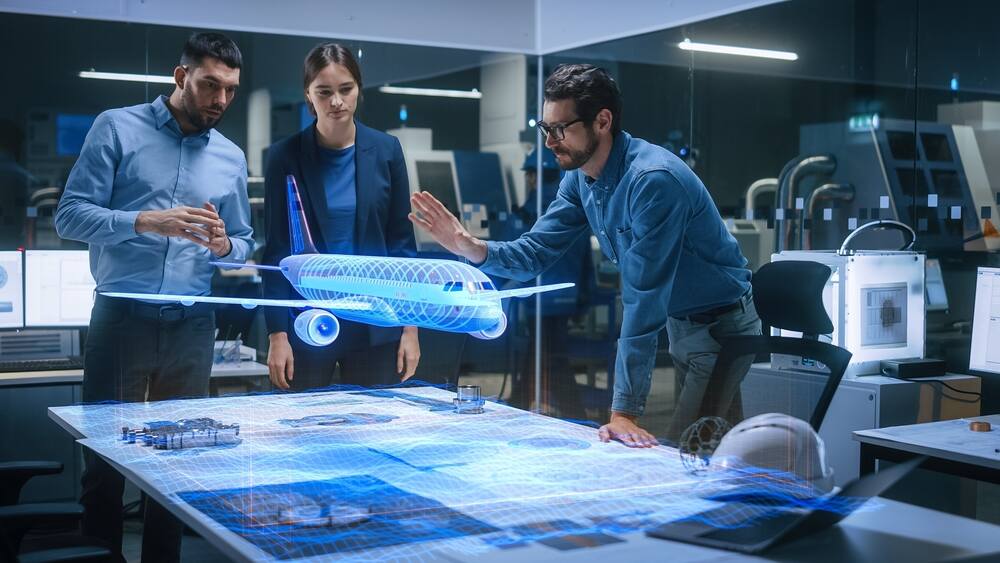The aerospace and defense (A&D) industry is characterized by its cutting-edge technologies and critical role in national security. It’s undeniably a cornerstone of modern civilization.
As technological advancements continue to permeate various sectors, artificial intelligence (AI) emerges as a force of transformation, redefining the paradigms of the A&D industry.
Aerospace and Defense Industry Overview
A bird’s-eye view of the aerospace and defense industry reveals a dynamic, multifaceted ecosystem.
Key players like Northrop Grumman, Lockheed Martin Corporation, and the Boeing Company dominate the arena, driving innovation and setting industry standards. These aerospace and defense industry companies operate in an environment that’s constantly influenced by geopolitical tensions, economic fluctuations, and technological evolutions.
Notably, the COVID-19 pandemic created unprecedented challenges for the industry, leading to significant supply chain disruptions. Commercial aircraft witnessed a slump in demand due to restrictions in air travel, while defense sectors had to navigate the complexities of remote operations and procurement delays.
However, even in these testing times, the industry’s resilience has been evident, with companies building innovative solutions to mitigate challenges.
Trends Shaping the A&D Industry

In recent years, several aerospace and defense industry trends have emerged, reshaping the way A&D entities operate:
- AI and Machine Learning: As industries worldwide harness AI’s power, the A&D sector is no exception. From optimizing flight paths for fuel efficiency to predictive maintenance for aircraft, AI’s applications seem boundless. Machine learning, a subset of AI, is instrumental in processing vast amounts of data to derive actionable insights, significantly impacting decision-making processes.
- Data Analytics: The modern A&D industry is awash with data, from flight telemetry to supply chain logistics. Data analytics tools help in sifting through this data deluge, extracting patterns, predicting future trends, and ensuring that companies remain steps ahead in their strategic planning.
- Sustainability and Fuel Efficiency: With the global push towards sustainability, the aerospace segment is under increasing pressure to enhance fuel efficiencies. AI plays a pivotal role here, helping design more aerodynamic structures and optimizing flight routes to reduce carbon footprints.
The Rise of AI in Aerospace
The marriage of AI and aerospace seems like a natural progression, given the industry’s reliance on technology and innovation. Here’s how AI is revolutionizing the aerospace segment:
- Commercial Aircraft Optimization: AI systems, integrated into commercial aircraft, can process real-time data to optimize flight paths, ensuring quicker travel times while consuming less fuel. This not only enhances passenger satisfaction but also leads to significant cost savings for airlines.
- Predictive Maintenance: AI algorithms can predict when parts of an aircraft are likely to fail or require maintenance. Such predictions, based on historical data and real-time monitoring, mean that airlines can preemptively address issues, reducing downtime and enhancing safety.
- Market Dynamics: As AI continues to permeate commercial aviation, companies that swiftly adopt and integrate these technologies stand to gain a significant edge in market share. Forward-thinking airlines and aerospace companies are investing heavily in AI, anticipating a future where AI-driven operations become the industry norm.
Artificial Intelligence in Defense
While the commercial aerospace sector reaps the rewards of AI integration, the defense sector is undergoing a similar revolution, albeit with higher stakes and intricacies:
- Military Aircraft and Weapon Systems: AI systems are becoming indispensable in modern military operations. Advanced algorithms enable aircraft to execute complex maneuvers, analyze vast datasets in real-time, and offer predictive insights, enhancing strategic operations. AI-driven weapon systems can identify and prioritize targets with precision, enhancing efficacy and minimizing collateral damage.
- Defense Manufacturers’ Innovations: Giants like Lockheed Martin Corporation are at the forefront, harnessing AI’s potential in their manufacturing processes, simulations, and combat systems. With the aim of establishing dominance on the battlefield and in the market, AI integration by defense manufacturers is ensuring faster response times, enhanced precision, and streamlined operations.
- Strategic Intelligence: AI aids defense forces in sorting through massive amounts of intelligence data, filtering out noise, and pinpointing critical pieces of information. This accelerated data analysis allows for faster, more informed decisions on the battlefield and during strategic planning.
Practical Implementation
To grasp AI’s profound impact on the A&D industry, one need not look further than the practical implementations by industry behemoths:
- Northrop Grumman: This leading defense manufacturer has been investing heavily in AI to enhance its autonomous systems. Their ventures range from developing advanced drones equipped with AI for reconnaissance to AI-driven cybersecurity solutions safeguarding critical infrastructures.
- The Boeing Company: Beyond commercial aviation, Boeing’s defense sector is leveraging AI for simulation training, predictive maintenance, and in the development of autonomous vehicles, ensuring their products remain at the cutting edge of military technology.
Future Implications and Considerations
As AI continues to weave itself into the fabric of the aerospace and defense sectors, its future implications beckon careful consideration:
- Ethical Dilemmas: The combination of AI and defense, especially in autonomous weapon systems, raises significant ethical concerns. Who’s accountable if an AI-driven weapon malfunctions? Establishing clear guidelines and ensuring human oversight is crucial.
- Workforce Implications: As AI systems become more integrated, there will be a need for a workforce adept in AI technologies. Continuous training and upskilling will be vital to ensure human-AI collaboration is effective and seamless.
- Security Concerns: As defense systems become more reliant on AI, they also become potential targets for cyber-attacks. Investing in AI-driven cybersecurity will be paramount to protect critical information and systems.
Conclusion
The aerospace and defense industry, always at technology’s forefront, is undergoing a seismic shift with AI’s integration. From commercial airlines to military battlefields, AI’s footprint is evident and growing. For companies and nations, the message is clear: Embrace AI’s potential, invest in its promise, and navigate its challenges with foresight.
The future of the A&D industry, influenced by AI, promises advancements that, a decade ago, might have been the stuff of science fiction. Yet, as with all great leaps forward, it beckons careful navigation, ensuring the balance between progress and prudence.
